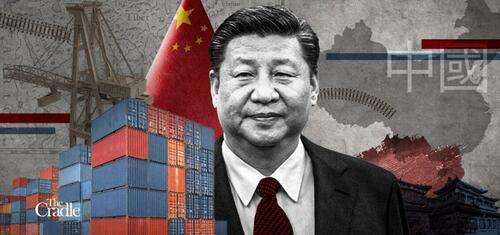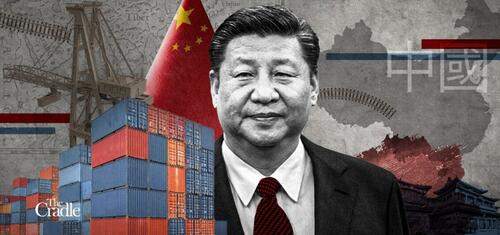Authored by Pepe Escobar via The Cradle,
In less than a decade, China’s BRI has fundamentally transformed global geopolitics. It is already far too late for the west to compete…
It is important to recognize that the US/NATO proxy war against Russia in Ukraine is simultaneously a war designed to interrupt the progress of China’s Belt and Road Initiative (BRI).
As we approach the 10th anniversary of the BRI, to be marked by the third Belt and Road Forum later this year in Beijing, it is clear the original Silk Road Economic Belt – announced by President Xi Jinping in Astana, Kazakhstan, in September 2013 – has traveled a long way.
By January this year, 151 nations had already signed up to the BRI: No less than 75 percent of the world’s population that represents more than half of the global GDP. Even an Atlanticist outfit such as the London-based Center for Economic and Business Research admits that the BRI may increase global GDP by a whopping $7.1 trillion a year by 2040, dispensing “widespread” benefits.
Included in the Chinese Constitution since 2018, BRI constitutes the de facto overarching Chinese foreign policy framework all the way to 2049, marking the centenary of the People’s Republic of China.
The BRI advances along several overland connectivity corridors – from the Trans-Siberian to the “middle corridor” along Iran and Turkiye and the China-Pakistan Economic Corridor (CPEC) all the way to the Arabian Sea. Meanwhile, on the waterways front, the Maritime Silk Road offers a parallel network from southeast China to the Persian Gulf, the Red Sea, the Swahili Coast, and the Mediterranean Sea.
All that is mirrored by the Russian-driven Northern Sea Route, connecting the eastern and western sides of the Arctic, and reducing to and fro sailing time from Europe to Asia from one month to less than two weeks.
Such a massive Make Trade Not War project, centered on connectivity, infrastructure building, sustainable development, and diplomatic acumen – focusing on the Global South – could not but be interpreted by western elites as a supreme geopolitical and geoeconomic threat.
And that’s why every geopolitical turbulence across the chessboard is directly or indirectly linked to BRI. Including Ukraine.
“A brand new choice”
At the Lanting Forum in Shanghai in May, Chinese Foreign Minister Qin Gang was at ease presenting to a select foreign audience the key outlines of “modernization, the Chinese way” and how it can be applied across the Global South.
For their part, Global South experts had a chance to dwell on the motives underneath the collective west’s constant “threat” paranoia. The bottom line is that for the US and its vassal allies, it is anathema that Beijing – based on its own success – is offering an alternative development model compared to the sole product on the market since 1945.
Former Brazilian President Dilma Rousseff, currently the new president of the Shanghai-based New Development Bank (NDB) – the BRICS bank – explained to the forum how neoliberalism was forced onto Latin America as a false path towards economic success. The Chinese model, on the other hand, as she stressed, now offers a “brand new choice,” which respects national peculiarities.
Zhou Qiangwu, the Chinese vice president of NDB, expects that this will push the IMF and the World Bank to give the Global South more say in their decision-making as part of new “governance solutions.”
Yet that’s unlikely to happen because the US and its vassals are not mentally prepared to get rid of their baggage of centuries-old prejudice and sit down at the same table with Global South representatives and accept them as equals as well as qualified stakeholders.
The Global South though, waits for no one. Round tables are already following each other at dizzying speed. A key case was the May 18-19 China-Central Asia summit in the former imperial capital, Xi’an, when President Xi met with the presidents of Kazakhstan, Kyrgyzstan, Tajikistan, Turkmenistan, and Uzbekistan – the five former USSR republics in the Heartland.
That followed Russian President Vladimir Putin meeting the same five “stans” in Moscow on the extremely significant 9 May, Victory Day.
Diplomatically, that suggests an already evolving 5+2 axis uniting Russia, China, and the five stans operating via their own secretariat in a slightly different manner from BRI, the Shanghai Cooperation Organization (SCO), and the Eurasia Economic Union (EAEU).
And why is that? Because of a problem that will be afflicting all of these new multilateral Global South-led organizations: Internal frictions.
And that brings us to the presence of India inside the SCO, an organization that privileges consensus in every decision.
That’s a huge issue when in contrast with the intractable India-Pakistan conflict, and even more sensitive when it comes to New Delhi’s wobbling stance regarding Quad and AUKUS. At least the Indians have not totally submitted to NATO in its hybrid war against Russia-China and its dream of dictating terms in the Indo-Pacific.
“A large-scale Eurasian partnership”
Xi and Putin have fully understood the strategic energy stakes: Increased shipments of Russian oil and gas to China equal way more transit across the Heartland. So a fully integrated strategy is a must. And it will have to be integrated at the level of BRI and EAEU interaction, even if there may be a “gap” inside the SCO.
Practical examples include accelerating the construction of the ultra-strategic Xinjiang-Kyrgyzstan-Uzbekistan railway, which has been delayed for years: That will boost further connectivity with Afghanistan, Pakistan, and Iran.
In parallel, CPEC will be extended to Afghanistan: That was finally decided on during an AfPak-China ministerial meeting in Islamabad on 5 May. Although a very thorny dossier still remains: How to deal with, cajole, and satisfy the Taliban leadership in Kabul.
Xi and the Heartland leaders in Xi’an forcefully committed to preventing “foreign interference” and proverbial color revolution attempts. These are all engineered to disturb BRI.
Now compare it with the G7 meeting in Hiroshima – which was yet another thinly disguised exercise about “containing” China. The Hiroshima communiqué, issued on May 20, a day after Xi and Central Asia in Xi’an, was heavy on “de-risking” – the new Western mantra that replaces “decoupling.”
The EU had already telegraphed the move via notorious European Commission President Ursula von der Leyen: Deception rules, because the concept that really matters, “economic coercion,” persists. Yet no serious Global South player thinks he’s being “coerced” to join BRI.
Comic relief was offered via the G7 committing to raise a whopping $600 billion in funding to build “quality infrastructure” via a so-called Global Infrastructure Investment Partnership: Call it the white man’s burden answer to BRI.
The fact remains that no one – from the western-monikered “Indo-Pacific” to ASEAN and the Pacific Islands Forum (PIF) – is demonstrating any sign of being “coerced” by China, not to mention showing any interest in ditching or antagonizing a wealth of trade and connectivity prospects.
At the EAEU summit in Moscow in late May, it was up to Putin to cut to the chase by emphasizing Russia’s active cooperation with BRICS, SCO, ASEAN, GCC, and multilateral organizations in Africa and Latin America.
Putin explicitly referred to “building new sustainable logistics chains” and developing the key connection between the EAEU and the International North-South Transportation Corridor (INTSC).
It gets better. He also emphasized working with China to “link the integration processes” of the EAEU and BRI, thus “implementing the large-scale idea of building a large-scale Eurasian partnership.”
It’s all here: Everything that makes Atlanticist elites howl in desperation. Old fox Belarusian President Alexander Lukashenko, who has seen it all since his USSR days, summed it up thus: Combining integration efforts – EAEU, SCO, BRICS – “will contribute to the creation of the largest coalition of states.”
And he came up with the money quote that will surely reverberate all across the Global South: “If we lose time – we will never make up for it. The one who runs faster now will be in the vanguard for a couple of decades.”
The jade tiger pounces
All that brings us to Shangri-La, East Asia’s premier dialogue platform in Singapore, this in June.
The real highlight was State Councilor and Defense Minister General Li Shangfu explaining China’s “New Security Initiative” in detail.
Li stressed the concept of “common, comprehensive, cooperative and sustainable security.” Remember: That’s exactly what Moscow was proposing to Washington in December 2021, which was met with a non-response response.
He noted that China is “ready to work with all parties” to strengthen the awareness of an “Asia-Pacific community with a shared future” (Note: Asia-Pacific is the denomination everyone in the region understands, not “Indo-Pacific”).
And then he got to the nitty-gritty: Taiwan is China’s Taiwan. And how to solve the Taiwan question is the Chinese people’s business. The message could not be more straightforward:
“If anyone dares to split Taiwan from China, the Chinese military will resolutely safeguard China’s national sovereignty and territorial integrity without any hesitation, at all cost, and not fearing any opponent.”
The Chinese delegation at the Shangri-La totally dismissed the “so-called ‘Indo-Pacific strategy’” as a tawdry Hegemon rant.
What Shangri-La unveiled was, in fact, Beijing’s clear, concise response to all those dismissals of BRI, all that carping about “debt trap” and “economic coercion,” all that “de-risking” rhetoric, and all those mounting intimations of false flags in Taiwan leading to the “real” war that the neocons in charge of US foreign policy dream about.
Obviously, intellectually shallow Beltway types won’t get the message. Especially because Li Shangfu was as polished as a jade tiger – elegantly pouncing over an avalanche of lies. You wanna mess with us? We’re ready. The barbarians predictably will keep rattling at the gate. The jade tiger awaits.








